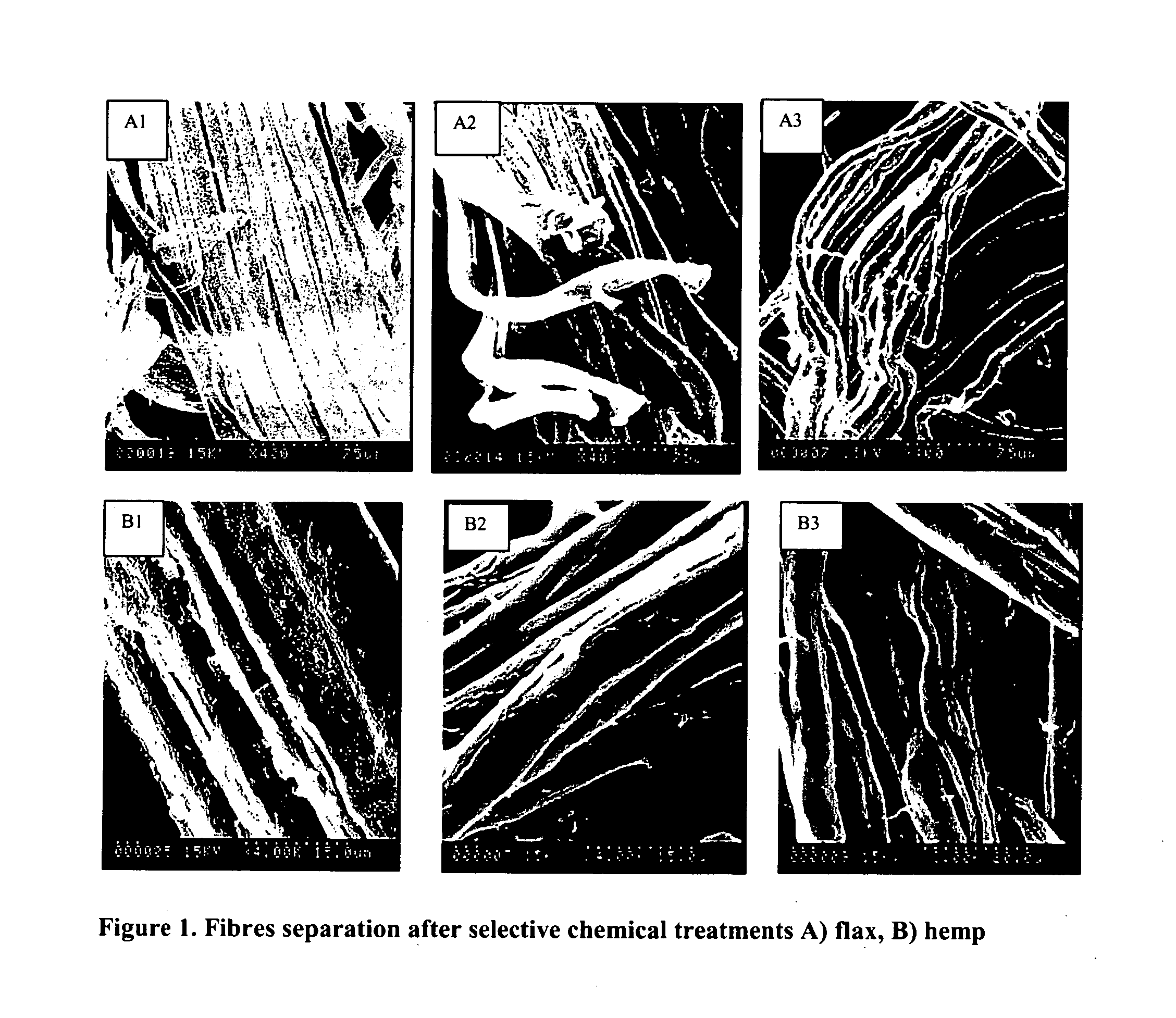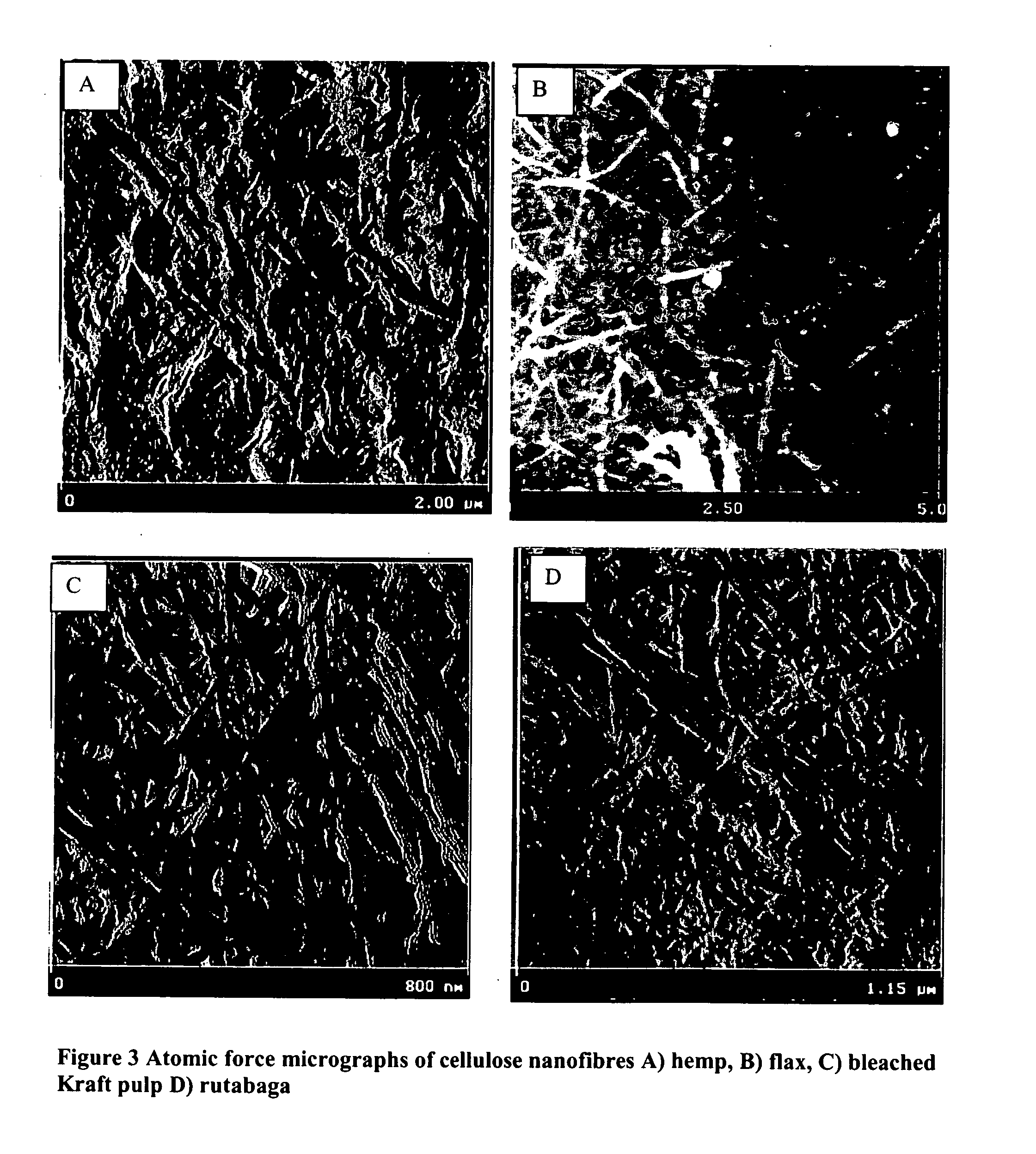Manufacturing process of cellulose nanofibers from renewable feed stocks
a technology of cellulose nanofibers and feed stocks, which is applied in the field of manufacturing process of cellulose nanofibers from renewable feed stocks, can solve the problems of contamination problems in alimentary applications, high cost of bacterial cellulose microfibers, and limited raw material choice, and achieves high strength, high reinforcing potential, and high aspect ratio
- Summary
- Abstract
- Description
- Claims
- Application Information
AI Technical Summary
Benefits of technology
Problems solved by technology
Method used
Image
Examples
example 1
[0082]Preparation of Nanofibers from Flax Fibers.
[0083]After having soaked the flax long fibers overnight in alkali of 17.5% w / w concentration, the fibers were washed thoroughly with distilled water. They are then treated with dilute acid preferably HCl between 1-3 hours at 80-90 degree C. The fibers were then washed again and treated with alkali of 2% w / w concentration for 2 hours between 80 and 100 degree C. with constant mechanical stirring. Fibers were washed again and cryocrushed with liquid nitrogen to break the cell wall in fragments to get the nanofibers out of the cell wall by applying high impact.
[0084]The sample was then disintegrated for 10 minutes at 2000-RPM speed at 2% consistency. The suspension was then subjected to high-pressure shear in homogenizer to obtain nanofibers. The pressure was maintained between 20 and 100 MPa, preferably between 30 and 70 MPa. The suspension was passed between 5 and 30 passes, preferably between 15 and 25 passes. This suspension is homo...
example 2
[0089]Defibrillation Without Chemical Treatments
[0090]Natural fibers have length in the range of 5-25 mm and they exist in the form of fiber bundles. Fibers are tightly attached to each other with pectin, which act as cement to bind them together as a bundle of fibers. Without removing the pectic substances it is very difficult to individualise fibers for defibrillation. Moreover the opening of the nozzle in the defibrillator equipment is approximately 1-2 mm and when we pass the suspension of fibers of length 2-25 mm, it chokes the nozzle opening and no circulation is possible for defibrillation.
example 3
[0091]Defibrillation with Chemical Treatments and Without High Pressure Defibrillation
[0092]In one experiment, chemical treatment of the fibers was done but high pressure was not applied for the defibrillation of the fibrils. Then the samples were analyzed using optical microscopy. FIG. 13 shows the fibrils after defibrillation without high pressure and it is clear that still the fibrils are attached to each other and are in the form of bundles. Therefore it is essential to apply a high pressure to isolate theses nanofibers from each other.
PUM
| Property | Measurement | Unit |
|---|---|---|
| diameter | aaaaa | aaaaa |
| pressure | aaaaa | aaaaa |
| diameter | aaaaa | aaaaa |
Abstract
Description
Claims
Application Information
 Login to View More
Login to View More - R&D
- Intellectual Property
- Life Sciences
- Materials
- Tech Scout
- Unparalleled Data Quality
- Higher Quality Content
- 60% Fewer Hallucinations
Browse by: Latest US Patents, China's latest patents, Technical Efficacy Thesaurus, Application Domain, Technology Topic, Popular Technical Reports.
© 2025 PatSnap. All rights reserved.Legal|Privacy policy|Modern Slavery Act Transparency Statement|Sitemap|About US| Contact US: help@patsnap.com



